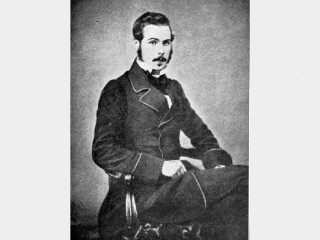
Archibald Scott Couper biography
Date of birth : 1831-03-31
Date of death : 1892-03-11
Birthplace : Kirkintilloch, Scotland
Nationality : Scottish
Category : Science and Technology
Last modified : 2010-12-20
Credited as : Chemist, recognize the etravalency of carbon,
The British chemist Archibald Scott Couper shares with Kekule the distinction of recognizing the tetravalency of carbon and the capacity of carbon atoms to combine to form chains, thereby providing the basis for structural organic chemistry.
Archibald Scott Couper was born on March 31, 1831, at Kirkintilloch in Dumbartonshire, Scotland, the son of a prosperous cotton weaver. He commenced his university studies at Glasgow mainly in classics, spent the summer semester of 1852 in Berlin, and returned to Scotland to complete his university course in logic and metaphysics at Edinburgh. He spent the period 1854-1856 in Berlin and during this time decided to study chemistry.
Couper entered the laboratory of Charles Wurtz in Paris in the autumn of 1856 and remained there until his return to Scotland in 1858; during these 2 years he made all his contributions to chemistry: two papers containing experimental contributions and his now famous memoir "On a New Chemical Theory." A few months after his return to Edinburgh to be assistant to Lyon Playfair, in the autumn of 1858, he suffered a severe nervous breakdown, followed by a general breakdown in health. He retired to Kirkintilloch and lived there incapable of intellectual work and completely lost to chemistry until his death 34 years later.
The story of Couper's work, its subsequent disappearance from view, and its later recognition, largely through the efforts of Richard Anschütz, as a major piece of chemical history is one of the most remarkable in science. Early in 1858 Couper, then 27 and after only some 3 years' contact with chemistry, asked Wurtz to present Couper's manuscript "On a New Chemical Theory" to the French Academy. Wurtz, however, delayed taking any steps, and in the interim August Kekule's paper "On the Constitution and Metamorphoses of Chemical Compounds and on the Chemical Nature of Carbon" appeared, containing essentially similar proposals. Couper protested to Wurtz about his procrastination but was, it is said, shown out of the laboratory.
Couper's paper was, however, finally presented by Jean Baptiste Dumas to the academy on June 14, 1858, and published in the Comptes rendus; fuller versions were subsequently published in English and French. After pointing out the inadequacy of current theories, Couper wrote in his paper: "I propose to consider the single element carbon. This body is found to have two highly distinguished characteristics: (1) It combines with equal numbers of equivalents of hydrogen, chlorine, oxygen, sulphur, etc. (2) It enters into chemical combination with itself. These two properties, in my opinion, explain all that is characteristic of organic chemistry. This will be rendered apparent as I advance. This second property is, so far as I am aware, here signalized for the first time."
Couper also introduced the use of a line to indicate the valence linkage between two atoms and, had he used 16 rather than 8 for the atomic weight of oxygen, his chemical formulas would have been almost identical with those used today. It is also remarkable that in his paper he represents cyanuric acid by a formula containing a ring of three carbon and three nitrogen atoms joined by valence lines—the first ring formula ever published. The introduction of ring formulas is often ascribed to Kekule, who in 1865 used this concept to develop his formula for benzene. It is interesting to speculate whether Couper might have anticipated Kekule's formulation of aromatic compounds had he been able to continue his chemical work. But Couper's paper "On a New Chemical Theory" remains a landmark in the history of organic chemistry.
Alexander Findlay, A Hundred Years of Chemistry (1937; 3d ed. 1965), discusses Couper's work and includes a short bibliography. See also Eduard Farber, The Evolution of Chemistry: A History of Its Ideas, Methods and Materials (1952; 2d ed. 1969).
















